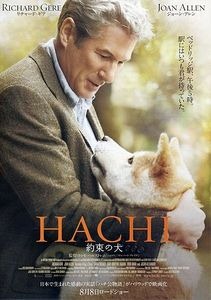 Hachiko: A Dog’s Story (2009) – on rental. Maybe it was because I was still feeling ill yesterday Saturday afternoon when I gave this supposed cry-fest of a film a go. Long story short, I thought the film really wasn’t very good… despite all the rave reviews that’s been heaped online for it.
Hachiko: A Dog’s Story (2009) – on rental. Maybe it was because I was still feeling ill yesterday Saturday afternoon when I gave this supposed cry-fest of a film a go. Long story short, I thought the film really wasn’t very good… despite all the rave reviews that’s been heaped online for it.
This 2009 film is the Hollywood version of a true story of a very loyal Akita dog named Hachiko who lived in Japan in the 1930s. His owner was a professor at the University of Tokyo, and every day, Hachiko would send off his owner, and wait at the Shibuya train station for his return. This routine continued even past the day when the good professor died suddenly and for an astonishing further nine years, and the dog’s persistent loyalty for his dead master was noticed by other train commuters and whose story was eventually cast in legend with memorials and statues built for the loyal dog.
So, from the onset you expect the film to comprise two acts: the first comprising the obligatory cute scenes of man and companion bonding, and the second comprising the touching scenes where Hachiko returns to the train station every day to wait for the master that never returns. The source material is great, story is inherently touching. What could go wrong?
But both acts crashed for me in this 2009 film, but for different reasons. The first I largely center on the choice of actor to play Professor Wilson – Richard Gere. He might had been the heartthrob from yesteryear, but his portrayal of characters since Pretty Woman invariably bring about a degree of smugness that I dislike. I imagine that any actor in his 60s would had been fine for the role – Harrison Ford comes to mind and would had been a more likable professor character.
The other problem lied in that the film seemed undecided as to whether the first act of the film (up till the death of Prof. Wilson) should be centered on Hachiko or the humans with Hachiko. Ideally, it should had been the former, but I think it might had also been workable had it gone with the latter. What we get instead is a jarring oscillation from scenes that alternate between Hachiko’s point of view and not trivial scenes involving the Wilson family that have little to do with the Hachiko story. I’m thinking of one other film that wisely centered its attention on animals, keeping humans properly in the background and having them in scenes only as supplements to the primary actors – and that film was Babe.
The film changes in tenor in the second act after the Professor’s passing. The couple of scenes showing Hachiko returning to the train station to await his return do work, but again I thought it failed as an overall package because the new found human relationships between Hachiko and the ‘regulars’ at the train station, which include a train station operator Carl and a hotdog vendor Jasjeet, were never properly developed earlier. Jason Alexander of Seinfeld fame plays the former character, and as written actually has a opportunistic and unsavory air about himself when a news reporter arrives to find out more about this loyal dog. Equally recognizable also is Erick Avari whom I remember from his role in The Mummy and also in the SG-1 television series. His portrayal is more underplayed and empathic, though like Carl, there is no real depth or story arc in his role.
Most disappointing of the cast though was actress Joan Allen whom I’d always enjoy watching. Besides Gere, she next had the most screen time for a human character. Her character enjoyed some development early on when she initially resists Hachiko’s admission to the family, but after her transition to acceptance, she fades into the background with nothing more to do – only showing up in a significant scene towards the film’s end.
The other problems I had with the film are technical. There’s a dog-cam view that was utterly tacky. Watching this film will lead you to believe that dogs see the world in black-and-white with image noise grain added and with exactly the same field of view as humans. And the overtly piano and cello sentimental music: attractive for the first five minutes, until it’s repeated ad nauseum for the remaining 90 minutes.
At least the on-location shoot at Rhode Island made for very picturesque scenes. Also, Hachiko looked awfully cute. But as these things go, and as it happened after Babe and the first installment of Harry Potter, there were a lot of kids all of a sudden wanting pet pigs and owls. I wonder if that’s happened for this film.
In sum, disappointing. The real and touching story of Hachiko can be read here, and I’m gonna look for the 1987 Japanese film version. That should be better than this one. If we’re going to Tokyo later this year, I’ll see if we can go by his memorial too.
The litmus test is always Ling. She left about 30 minutes into the film to start up Hannah’s dinner. During the funeral scene, she popped her head out of the kitchen to ask “So the guy died already?”, then disinterestedly returned back to her work.





I love dogs